By Megrette Fletcher M.Ed, RD, CDCES Co-Author of Eat What You Love, Love What You Eat with Diabetes
 Is it possible to have a superhero for a vegetable? A vegetable that is mild-mannered, unassuming and often overlooked in the crowd of produce, disguised not by a pair of unfashionable glasses but by its distance from all the other fresh produce. Yet, once it enters the meal, everyone thinks, “Wow! That is nutritious.” You ask, “Who could this superhero vegetable be?” Beans! I know, you’re wondering whether they really are a vegetable. Yes, and their inclusion in the vegetable group surprised even Lois Lane. However, the USDA lists a half cup of beans as a full serving of vegetables. It also counts as 1 ounce of lean protein, and beans are considered an excellent source of fiber.
Is it possible to have a superhero for a vegetable? A vegetable that is mild-mannered, unassuming and often overlooked in the crowd of produce, disguised not by a pair of unfashionable glasses but by its distance from all the other fresh produce. Yet, once it enters the meal, everyone thinks, “Wow! That is nutritious.” You ask, “Who could this superhero vegetable be?” Beans! I know, you’re wondering whether they really are a vegetable. Yes, and their inclusion in the vegetable group surprised even Lois Lane. However, the USDA lists a half cup of beans as a full serving of vegetables. It also counts as 1 ounce of lean protein, and beans are considered an excellent source of fiber.
I Thought Beans were a Carbohydrate?
It is true that beans are a carbohydrate-containing vegetable, but that doesn’t mean they can’t be part of your meal plan. They would be grouped in the upper right hand corner of the Eat What You Love, Love What You Eat with Diabetes Plate.
Here is information that will give you a better understanding of the nutrition in beans:
A half cup of beans offers about 22 grams of carbohydrates, or 1.5 carbohydrate choice, 8 grams of fiber and 8 grams of protein. They are high in folic acid, B vitamins, phosphorus, magnesium, manganese, potassium, calcium and iron. If you are trying to increase your iron intake, pairing beans with a food that is high in vitamin C can increase absorption. An example of this would be adding diced peppers to a bean salad. (See recipe at bottom of this post.)
The focus of mindful eating is to increase your awareness of the amount of carbohydrates in your diet. You may wonder, “Should I really eat beans with a meal?” The answer is yes, if you enjoythem, because the unique qualities of beans do not seem to affect blood sugars like other carbohydrates. This is likely due to the fiber and protein found in them. Beans are not a complete protein because they are low in the amino acid methionine. But if beans are served with a grain, such as bread, rice or pasta, which is naturally high in methionine, they form a complete protein. For people with Type 2 diabetes, protein can blunt blood glucose rise, stimulate insulin release and increase the sense of fullness while eating. These factors and the glucose blunting effect of fiber work together to make beans a wonderful food to add to a meal to improve blood glucose control.
Experiment: Decide for yourself
If you would like to use the Fearless Blood Glucose Monitoring Log, click on resources to download a free copy of this handout.
Now:
- Check in with your hunger before a meal.
- Rate it using the Hunger/Fullness Scale (page 53 of Eat What You Love, Love What You Eat with Diabetes)
- If possible, check your blood sugars.
- Next choose a wide variety of food from around the plate.
- Really taste your meal, noticing your direct experience with each bite.
- Ask lots of questions, become curious and experiment pairing different flavors on the fork.
- When you are done eating (and yes, there may be food on the plate!), rate your fullness.
- If possible, test your blood sugars two hours after eating. (If you forget, try to check it before the next meal.)
- Evaluate your experience. Was eating beans a pleasant experience? What was your experience with fullness? Did hunger return quickly or did you feel fuller longer when beans were part of the meal?
- Now consider what other ways you might enjoy eating beans? Chili, soup, tacos or as a side dish?
It is true that adding beans to your diet may not make you able to leap tall buildings in a single bound, but beans can stabilize blood sugars, lower cholesterol, and help prevent certain types of cancer while providing vitamins and minerals at very little cost. In short, beans – canned or dried – are a superhero vegetable.
Three Bean Salad Medley
1 16-oz can black beans, rinsed
1 16-oz can white beans, rinsed
1 cup cooked corn (1 large ear, cut off cob is best)
1 cup cooked green beans, cut into 2-inch sections
1 diced pepper
2 cups blanched broccoli chopped
2 cups fresh tomatoes (grape tomatoes cut in half are great)
1 cucumber, chopped
1 diced red onion
Fresh chopped cilantro, basil, parsley, garlic (or herbs you enjoy) about 1 to 3 teaspoons each
Directions:
Combine ingredients in a large bowl. Mix. Add salad dressing when eating. Serving size: 1 cup. Carbohydrates 20-25 grams. Exchanges: 1.5-2 carbohydrate choices, 2 vegetable choices, 1oz. lean protein. This makes about 10-12 cups.
Still Hungry? Check out I Am Hungry! recipes here!
